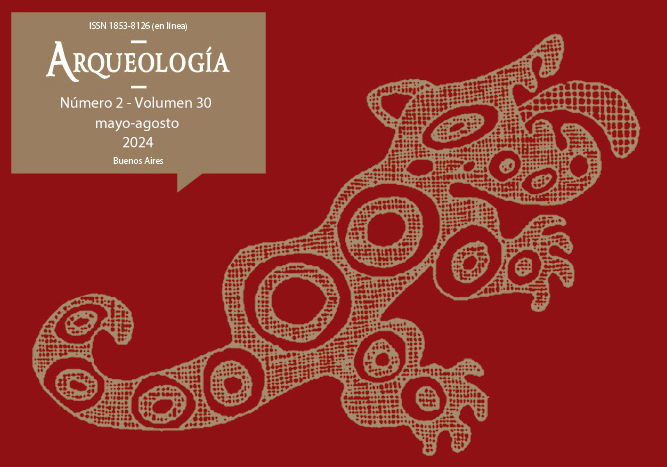Arqueología de la Salud Mental. Materialidad, uso del espacio y prácticas sociales en recintos de Salud Mental en Chile desde fines del siglo XIX hasta la actualidad
Descargas
Citas
Brandão Moreira, J. (2015). Arquitetura que enlouquece: Poder e Arqueologia (Tesis de Maestría inédita). Universidade Federal de Minas Gerais, Brasil. http://hdl.handle.net/1843/BUBD-A4UFTP
Brandão Moreira, J. (2017). Arquitetura da loucura: uma leitura arqueológica do Hospital de Neuropsiquiatria Infantil (Belo Horizonte - MG). Cadernos De História Da Ciência, 13(1), 27-55. https://doi.org/10.47692/cadhistcienc.2017.v13.33850
Brandão Moreira, J. (2021). Arqueologia da loucura: narrativas alternativas, cultura material e história do Hospital Colônia de Barbacena (Tesis de Doctorado inédita). Universidade Federal de Minas Gerais, Brasil. http://hdl.handle.net/1843/45725
Casella, E. (2001). Every Procurable Object: A Functional Analysis of the Ross Factory Archaeological Collection. Australasian Historical Archaeology, 19, 25-38. https://www.jstor.org/stable/29544465
Casella, E. (2002). Archaeology of the Ross Female Factory: Female Incarceration in Van Diemen's Land, Australia. Tasmania: Records of the Queen Victoria Museum, Volume 108. Report prepared for the Cultural Heritage Branch (DPIWE, Tasmania). Queen Victoria Museum and Art Gallery and the Tasmanian Wool Centre of Ross
Fennelly, K. (2014). Out of sound, out of mind: noise control in early nineteenth-century lunatic asylums in England and Ireland. World Archaeology, 46(3), 416-430. https://doi.org/10.1080/00438243.2014.909098
Fennelly, K. (2018). The Bedford Asylum: Building for the ‘Industrious Child’ in Early-Nineteenth Century Dublin. En J. E: Baxter y M. A. B. Elis (Eds.), Nineteenth century childhoods in interdisciplinary and international perspectives. Childhood in the Past (pp. 153-165). Oxford: Oxbow Books. https://doi.org/10.2307/j.ctvh1dh7v.15
Fennelly, K. (2019). An archaeology of lunacy. Managing madness in early nineteenth-century asylum. Manchester: Manchester University Press.
Funari, P. P. A. y Zarankin, A. (2003). Social archaeology of housing from a Latin American perspective: A case study. Journal of Social Archaeology, 3(1), 23-45. https://doi.org/10.1177/1469605303003001097
Goffman, E. (2001). Internados. Ensayo sobre la situación social de los enfermos mentales. Buenos Aires: Amorrortu editores.
Hillier B. y Hanson J. (1984). The Social Logic of Space. Cambridge: Cambridge University.
Lightfoot, K. G. (1995). Culture Contact Studies: Redefining the Relationship between Prehistoric and Historical Archaeology. American Antiquity, 60(2), 199-217. https://doi.org/10.2307/282137
Mañana Borrazás, P., Blanco Rotea, R. y Ayán Vila, X. (2002). Arqueotectura 1: Bases Teórico-Metodológicas para una Arqueología de la Arquitectura. Santiago de Compostela: Traballos de Arqueoloxía e Patrimonio (TAPA), 25. Laboratorio de Patrimonio, Paleoambiente e Paisaxe, nstituto de Investigacións Tecnolóxicas, Universidad de Santiago de Compostela. http://hdl.handle.net/10261/6027
Markus, T. (1993). Buildings & Power: Freedom and Control in the Origin of Modern Building Types. Londres y Nueva York: Routledge.
Moshenska, G. y Myers, A. (2011). An introduction to archaeologies of internment. En A. Myers y G. Moshenska (Eds.), Archaeologies of Internment. One World Archaeology (pp. 1-19). New York: Springer. https://doi.org/10.1007/978-1-4419-9666-4_1
Nuevo-Delaunay, A.y Letelier Cosmelli, J. (2024). Americas, South: Historical Archaeology. En T. Rehren y E. Nikita (Eds.), Encyclopedia of Archaeology (2nd Edition, Vol. 3, pp. 641-648). Londres: Academic Press. https://dx.doi.org/10.1016/B978-0-323-90799-6.00074-4
Orser, C. (2006). The Archaeologies of Recent History: Historical, Post-Medieval, and Modern World. En J. Bintliff (ed.), A Companion to Archaeology (pp. 272-290). Oxford: Blackwell.
Piddock, S. (2001a). Convicts and the Free: Nineteenth-century lunatic asylums in South Australia and Tasmania (1830-1883). Australasian Historical Archaeology, 19, 84-96. https://www.jstor.org/stable/29544470
Piddock, S. (2001b). An Irregular and Inconvenient Pile of Buildings: The Destitute Asylum of Adelaide, South Australia and the English Workhouse. International Journal of Historical Archaeology, 5, 73-95. https://doi.org/10.1023/A:1009597226492
Piddock, S. (2004). Possibilities and realities: SouthAustralia's asylums in the 19th century. Australasian Psychiatry, 12(2), 172-175. https://doi.org/10.1080/j.1039-8562.2004.02089.x
Piddock, S. (2007). A Space of Their Own: The Archaeology of Nineteenth Century Lunatic Asylums in Britain, South Australia, and Tasmania. Nueva York: Springer.
Piddock, S. (2009). John Conolly's 'Ideal' asylum and provisions for the insane in nineteenth-century South Australia and Tasmania. En A. M. Beisaw y J. G. Gibb (Eds.), The archaeology of institutional life (pp.187-205). Tuscaloosa: University of Alabama
Rathje, W. (1996). The Garbage Project & “The Archaeology of Us”. En I. Ciegelski (Ed.), Encyclopedia. Britannica's Yearbook of Science and the Future (pp. 158-177). Nueva York: Encyclopaedia Britannica.
Schiffer, M. (1988). ¿Existe una “premisa de Pompeya” en arqueología? Boletín de Antropología Americana, 18, 5-31.
Scull, A. (1989). Social Order/Mental Disorder: Anglo-American Psychiatry in Historical Perspective. Berkeley: University of California Press. http://ark.cdlib.org/ark:/13030/ft9r29p2x5/
Derechos de autor 2024 Javiera Letelier Cosmelli

Esta obra está bajo licencia internacional Creative Commons Reconocimiento-NoComercial-CompartirIgual 4.0.
Los autores/as que publiquen en esta revista aceptan las siguientes condiciones:
- Los autores/as conservan los derechos de autor y ceden a la revista el derecho de la primera publicación, con el trabajo registrado mediante Licencia Creative Commons 4.0 Internacional (CC-BY-NC-SA), que permite a terceros utilizar lo publicado siempre que mencionen la autoría del trabajo y a la primera publicación en esta revista.
- Los autores/as pueden realizar otros acuerdos contractuales independientes y adicionales para la distribución no exclusiva de la versión del artículo publicado en esta revista (p.e. incluirlo en un repositorio institucional o publicarlo en un libro) siempre que indiquen claramente que el trabajo se publicó por primera vez en esta revista.
- Se permite y recomienda a los autores/as a publicar su trabajo en Internet (p.e. en sus sitios web personales o en depósitos institucionales), tanto antes como después de su publicación en esta revista, siempre y cuando proporcionen información bibliográfica que acredite, si procede, su publicación en ella. De esta manera, pueden favorecerse intercambios productivos y a una mayor y más rápida difusión del trabajo publicado (vea The Effect of Open Access).





(1)13.png)






1.jpg)
1.png)
1.jpg)


13.png)
1.png)


(1)1.png)









